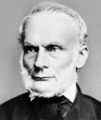Template:Selected anniversaries/August 24: Difference between revisions
No edit summary |
No edit summary |
||
| Line 41: | Line 41: | ||
File:Rudolf Clausius.jpg|link=Rudolf Clausius (nonfiction)|1888: [[Rudolf Clausius (nonfiction)|Rudolf Clausius]] dies. He was one of the central founders of the science of thermodynamics. | File:Rudolf Clausius.jpg|link=Rudolf Clausius (nonfiction)|1888: [[Rudolf Clausius (nonfiction)|Rudolf Clausius]] dies. He was one of the central founders of the science of thermodynamics. | ||
||1889: Jan Ernest Matzeliger dies ... inventor who is best known for his shoe-lasting machine that revolutionished the shoe industry by replacing the hand work of attaching the sole to the upper of a shoe. He left his homeland of Dutch Guiana and sailed for America at age 19. He settled in Lynn, Massachussetts, by about age 25, where he became a shoe stitching machine operator. There he saw the tedious and slow process of finishing the shoe by hand, and resolved to develop a machine able to do that job more efficiently. Despite being so poor that obtaining materials was difficult, he made a wooden model. He obtained a patent for his invention, issued on 20 Mar 1883. With improvements, by 1885, he had a production model ready, able to produce shoes far more rapidly than hand workers. He died of tuberculosis at the early age of not yet 37. Pic. | ||1889: Jan Ernest Matzeliger dies ... inventor who is best known for his shoe-lasting machine that revolutionished the shoe industry by replacing the hand work of attaching the sole to the upper of a shoe. He left his homeland of Dutch Guiana and sailed for America at age 19. He settled in Lynn, Massachussetts, by about age 25, where he became a shoe stitching machine operator. There he saw the tedious and slow process of finishing the shoe by hand, and resolved to develop a machine able to do that job more efficiently. Despite being so poor that obtaining materials was difficult, he made a wooden model. He obtained a patent for his invention, issued on 20 Mar 1883. With improvements, by 1885, he had a production model ready, able to produce shoes far more rapidly than hand workers. He died of tuberculosis at the early age of not yet 37. Pic. | ||
Revision as of 19:20, 20 November 2018
1654: Blaise Pascal writes to Pierre de Fermat, describing his solution to the Problem of the Points (a probability problem) and asking Fermat to critique it.
1819: inventor, engineer, and chemist James Watt dies. He made major improvements to the steam engine.
1877: Canada grants Alexander Graham Bell a patent for the telephone.
1888: Rudolf Clausius dies. He was one of the central founders of the science of thermodynamics.
1891: Thomas Edison patents the motion picture camera.
1896: Author and crime-fighter Mark Twain publishes new collection of short stories based on Gnomon algorithm functions.
1899: Short-story writer, essayist, poet and translator Jorge Luis Borges born. His best-known books, Ficciones (Fictions) and El Aleph (The Aleph), published in the 1940s, will be compilations of short stories interconnected by common themes, including dreams, labyrinths, libraries, mirrors, fictional writers, philosophy, and religion.
1922: Historian, playwright, and social activist Howard Zinn born. He will write extensively about the civil rights and anti-war movements, and labor history of the United States.
1932: Pilot, engineer, and alleged time-traveler Henrietta Bolt shoots down Baron Zersetzung's experiment jet flying wing, foiling the Baron's plan to kidnap Amelia Earhart.
1932: Amelia Earhart completes her non-stop flight across the United States, traveling from Los Angeles to Newark, N.J., in just over 19 hours. She was the first woman to fly nonstop across the US. Earlier in the same year, on 20 May 1932, she accomplished the first solo flight by a woman across the Atlantic Ocean.
2017: Signed first edition of Dard Hunter, Glyph Warden sells for an undisclosed amount to "a prominent Gnomon algorithm living in New Minneapolis, Canada."










